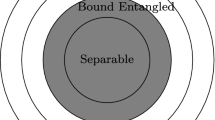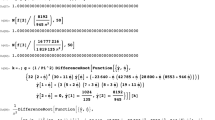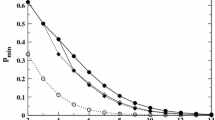Abstract
Milz and Strunz (J Phys A 48:035306, 2015) recently studied the probabilities that two-qubit and qubit–qutrit states, randomly generated with respect to Hilbert–Schmidt (Euclidean/flat) measure, are separable. They concluded that in both cases, the separability probabilities (apparently exactly \(\frac{8}{33}\) in the two-qubit scenario) hold constant over the Bloch radii (r) of the single-qubit subsystems, jumping to 1 at the pure state boundaries (\(r=1\)). Here, firstly, we present evidence that in the qubit–qutrit case, the separability probability is uniformly distributed, as well, over the generalized Bloch radius (R) of the qutrit subsystem. While the qubit (standard) Bloch vector is positioned in three-dimensional space, the qutrit generalized Bloch vector lives in eight-dimensional space. The radii variables r and R themselves are the lengths/norms (being square roots of quadratic Casimir invariants) of these (“coherence”) vectors. Additionally, we find that not only are the qubit–qutrit separability probabilities invariant over the quadratic Casimir invariant of the qutrit subsystem, but apparently also over the cubic one—and similarly the case, more generally, with the use of random induced measure. We also investigate two-qutrit (\(3 \times 3\)) and qubit–qudit (\(2 \times 4\)) systems—with seemingly analogous positive partial transpose-probability invariances holding over what has been termed by Altafini the partial Casimir invariants of these systems.















Similar content being viewed by others
References
Gamel, O.:arXiv preprint arXiv:1602.01548 (2016)
Bengtsson, I., Życzkowski, K.: Geometry of Quantum States. Cambridge University Press, Cambridge (2006)
Petz, D., Sudár, C.: Geometries of quantum states. J. Math. Phys. 37, 2662–2673 (1996)
Życzkowski, K., Horodecki, P., Sanpera, A., Lewenstein, M.: Volume of the set of separable states. Phys. Rev. A 58, 883 (1998)
Szarek, S., Bengtsson, I., Życzkowski, K.: On the structure of the body of states with positive partial transpose. J. Phys. A 39, L119 (2006)
Gerdt, V., Mladenov, D., Palii, Y., Khvedelidze, A.: SU(6) Casimir invariants and SU(2) \(\otimes \) SU(3) scalars for a mixed qubit-qutrit state. J. Math. Sci. 179, 690 (2011)
Goyal, S.K., Simon, B.N., Singh, R., Simon, S.: Geometry of the generalized Bloch sphere for qutrits. J. Phys. A: Math. Theor. 49, 165203 (2016)
Kimura, G.: The Bloch vector for N-level systems. Phys. Lett. A 314, 339–349 (2003)
Scutaru, H.: A new form of the characteristic equation of a density matrix. Proc. Roman. Acad Sci. 6, 212–218 (2005)
Werner, R.F.: Quantum states with Einstein-Podolsky-Rosen correlations admitting a hidden-variable model. Phys. Rev. A 40, 4277 (1989)
Slater, P.B.: Dyson indices and Hilbert–Schmidt separability functions and probabilities. J. Phys. A 40, 14279 (2007)
Slater, P.B., Dunkl, C.F.: Moment-based evidence for simple rational-valued Hilbert–Schmidt generic 2 X 2 separability probabilities. J. Phys. A 45, 095305 (2012)
Slater, P.B.: A concise formula for generalized two-qubit Hilbert–Schmidt separability probabilities. J. Phys. A 46, 445302 (2013)
Fei, J., Joynt, R.: Numerical computations of separability probabilities. arXiv preprint arXiv:1409.1993 (2014)
Życzkowski, K., Sommers, H.-J.: Bures volume of the set of mixed quantum states. J. Phys. A 36, 10115 (2003)
Życzkowski, K., Sommers, H.-J.: Induced measures in the space of mixed quantum states. J. Phys. A A34, 7111 (2001)
Zeilberger, D.: A fast algorithm for proving terminating hypergeometric identities. Discret. Math. 80, 207–211 (1990)
Dumitriu, I., Edelman, A.: Matrix models for beta ensembles. J. Math. Phys. 43, 5830 (2002)
Milz, S., Strunz, W.T.: Volumes of conditioned bipartite state spaces. J. Phys. A 48, 035306 (2015)
Slater, P.B., Dunkl, C.F.: Formulas for rational-valued separability probabilities of random induced generalized two-qubit states. Adv. Math. Phys. 2015, 621353 (2015)
Jevtic, S., Pusey, M., Jennings, D., Rudolph, T.: Quantum steering ellipsoids. Phys. Rev. Lett. 113, 020402 (2014)
Slater, P.B.: arXiv preprint arXiv:1506.08739 (2015)
Byrd, M.S., Khaneja, N.: Characterization of the positivity of the density matrix in terms of the coherence vector representation. Phys. Rev. A 68, 062322 (2003)
De Vicente, J.I.: Separability criteria based on the Bloch representation of density matrices. Quantum Inf. Comput. 7, 624 (2007)
Życzkowski, K., Penson, K.A., Nechita, I., Collins, B.: Generating random density matrices. J. Math. Phys. 52, 062201 (2011)
Peres, A.: Separability criterion for density matrices. Phys. Rev. Lett. 77, 1413 (1996)
Horodecki, M., Horodecki, P., Horodecki, R.: Separability of mixed states: necessary and sufficient conditions. Phys. Lett. A 223, 1–8 (1996)
Krishnamoorthy, K., Peng, J.: Exact properties of a new test and other tests for differences between several binomial proportions. J. Appl. Stat. Sci. 16, 411–423 (2009)
Vértesi, T., Brunner, N.: Disproving the Peres conjecture by showing Bell nonlocality from bound entanglement. Nat. Commun. 5, 5297 (2014)
Jarvis, P.D.: The mixed two qutrit system: local unitary invariants, entanglement monotones, and the SLOCC group. J. Phys. A Math. Theor. 47, 215302 (2014)
Brown, L.D., Cai, T.T., DasGupta, A.: Interval estimation for a binomial proportion. Stat. Sci. 16, 101–117 (2001)
Boya, L.J., Dixit, K.: Geometry of density matrix states. Phys. Rev. A 78, 042108 (2008)
Makhlin, Y.: Nonlocal properties of two-qubit gates and mixed states, and the optimization of quantum computations. Quantum Inf. Process. 1, 243–252 (2002)
Khvedelidze, A., Rogojin, I.: On the geometric probability of entangled mixed states. J. Math. Sci. 209, 988–1004 (2015)
Gerdt, V., Khvedelidze, A., Palii, Y.: On the ring of local polynomial invariants for a pair of entangled qubits. J. Math. Sci. 168, 368–378 (2010)
Slater, P.B.: arXiv preprint arXiv:1504.04555 (2015)
Brody, D.C., Graefe, E.-M.: Six-dimensional space-time from quaternionic quantum mechanics. Phys. Rev. D 84, 125016 (2011)
Gerdt, V., Khvedelidze, A., Palii, Y.: Constraints on SU (2) \(\times \) SU (2) invariant polynomials for a pair of entangled qubits. Phys. At. Nucl. 74, 893–900 (2011)
Dunkl, C.F., Slater, P.B.: Separability probability formulas and their proofs for generalized two-qubit X-matrices endowed with Hilbert–Schmidt and induced measures. Random Matrices Theory Appl. 4, 1550018 (2015)
Aubrun, G., Szarek, S.J., Ye, D.: Entanglement thresholds for random induced states. Commun. Pure Appl. Math. 67, 129–171 (2014)
Sommers, H.-J., Życzkowski, K.: Bures volume of the set of mixed quantum states. J. Phys. A 36, 10083–10100 (2003)
Altafini, C.: Tensor of coherences parametrization of multiqubit density operators for entanglement characterization. Phys. Rev. A 69, 012311 (2004)
Author information
Authors and Affiliations
Corresponding author
Rights and permissions
About this article
Cite this article
Slater, P.B. Invariance of bipartite separability and PPT-probabilities over Casimir invariants of reduced states. Quantum Inf Process 15, 3745–3760 (2016). https://doi.org/10.1007/s11128-016-1352-6
Received:
Accepted:
Published:
Issue Date:
DOI: https://doi.org/10.1007/s11128-016-1352-6




